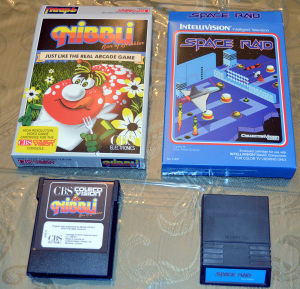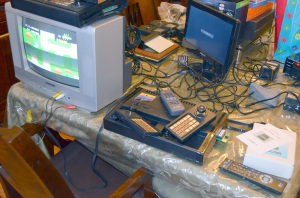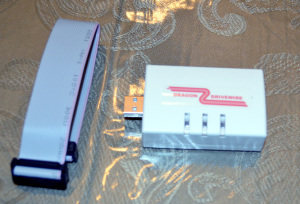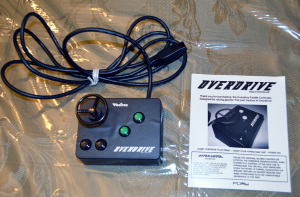Bill Loguidice's Blog, page 126
December 3, 2014
The design of the Nintendo 3DS was rendered back in 1983!
Thanks to Kris Pyrz in the Facebook Group, I Am a Classic Videogamer, for the heads-up on a rendering of Palmtex’s PVS handheld videogame system in the May 1983 issue of Video Game magazine. Here’s what the bottom half of page 10 of that issue looks like:
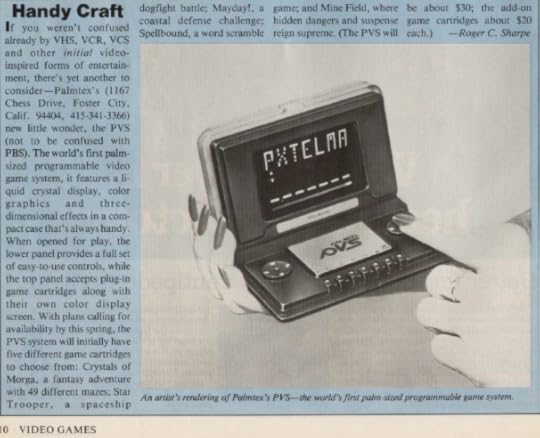
To say the bottom of page 10 of the May 1983 issue of Video Games magazine is interesting is an understatement.
Notice anything familiar? Yep, it looks an awful lot like the Nintendo DS Lite (2006) and today’s Nintendo 3DS handhelds:

Evan Amos’s photo of the Nintendo DS Lite from Wikipedia.
Much like many of the artist renderings from back in the day, the final design of the released version of the PVS was not quite the same. In fact, it looked quite a bit different as you can see here and here (Bonus: Here’s a video of one of its relatively impressive games in action!). Nevertheless, it’s fascinating to note that what we think of as a relatively modern design had its roots relatively long ago. Of course, Nintendo clearly didn’t take inspiration from Palmtex’s rendering as they had their own Game & Watch handheld, shown below, with actual dual screens well before, but the similarities with the PVS rendering, despite its lack of a second screen, are still more striking.

Nintendo’s Oil Panic Game & Watch handheld, released May 28, 1982. Source: Wikipedia.
As always, there’s a lot to love about videogame history!
Want to support Armchair Arcade?

December 1, 2014
35 Reviews for CoCo: The Colorful History of Tandy’s Underdog Computer!
The 35th Amazon.com review for one of our recent books, CoCo: The Colorful History of Tandy’s Underdog Computer, just hit, and it’s another five stars! Hitting this latest milestone is yet another great example of the tremendous support we’ve received for this particular book, which my co-author and I greatly appreciate, making all of the hard work that went into this project well worth it. As always if you have any questions about this particular book or any of our other books or film, drop us a line or leave a comment. Thanks!
November 18, 2014
A successful move back to iPhone from Android!
I’m happy to report that – at least based on the early going – my transition back to the iPhone from Android is a resounding success. While I’ve only had the iPhone 6 Plus for effectively three days, I’ve been able to do every possible real world test that I needed to. As noted in my earlier blog post, I grew frustrated with the Bluetooth (and other) issues from two successive Android phones (Samsung Galaxy Note II and HTC One M8), where even switching Bluetooth on and off wouldn’t always successfully restore a connection. Now, with the iPhone 6 Plus, Bluetooth works exactly the way it’s supposed to (particularly in my car, which at present is a Toyota Prius; as noted previously, my prior car, a Ford Fiesta, had similar issues with my Android phones), seamlessly and without any extra effort on my part.
Any other concerns over features or functionality not being present in iOS that are present in Android also proved to be without merit. I’ve said it before and I’ll state it again from up-to-the-moment-experience that for the vast majority of features/needs/requirements, there is effectively zero functional difference between having an Android-based phone and iOS-based phone. Of course there are one-off examples, like the nifty S-Pen stylus of the Galaxy Note 4 or the reliable fingerprint sensor of the iPhone 6 for easy security/password authorization (it really does save time!), but those are relatively minor details that may or may not be important to a particular individual. Overall, app-for-app and function-for-function, this is just about the best possible type of stalemate for consumers, effectively providing a coin toss choice between two different ecosystems once any brand bias is taken out of the equation.
In my time with the iPhone 6 Plus, here are some of the more interesting and positive things I noted in the switch:
A. As expected, my AT&T iPhone 6 Plus was free of carrier bloatware. While it goes without saying bloatware was a problem on my Galaxy Note II (and quite a bit of it was Samsung’s doing), it was also an annoyance on my HTC One M8. If I do ever switch back to Android in the future, it will absolutely be for a Nexus-style device with as pure of a Google experience as possible, which is the equivalent to what you get with the Apple phones.
B. No more waiting for carrier operating system updates that may or may not ever get pushed through. Having an iPhone means I get new updates pushed to me when Apple has them ready. In fact, I’ve already gotten one in the short time I’ve owned the phone, which matches all of the updates I had gotten during the whole time I owned each of my previous two Android phones.
C. The default apps, like Mail, are far more functional than the default apps I’ve experienced on Android. For instance, I was going to use CloudMagic for email like I did on Android (needing to support half a dozen email accounts, including a work Exchange-based account), but decided to delete it since I could get the same functionality and a bit more out of the default app.
D. The I-don’t-care-which-way-you-plug-me-in lightning cable. It makes life much easier. Of course, you still have the old style USB plug on the other end, which does need to be plugged in the right way. (Frankly, the sooner we get away from uni-connectors on ALL of our devices, the better, and I’m glad to know that we should be mostly transitioned within five years, though of course it would be nice if it were sooner)
E. Better integration with my Pebble smartwatch (as described in this blog post). The way the notification system works on iOS seems to work better with this device than it did on Android, which required two different apps to get the type of functionality I needed. Now, I only need the default Pebble app on iOS. It seems to extend the battery life of my Pebble watch as well.

Spigen’s Tough Armor case on my iPhone 6 Plus
F. The choice of cases. While most of the major Android smartphones have a good selection of cases, what’s nice about the relatively small selection (still) of popular iOS devices is that you’re all but guaranteed that every major case maker (and then some) will make just the right type of case to suit your needs. Right now, I’m using a Spigen Tough Armor, but I suspect I’ll be upgrading in a few months to a different case. Even if I don’t, it’s a great case, despite the fact that I had to snip a small section on the bottom of the case to accommodate my third party charging cables (they have bigger connector end jackets than the Apple first party ones).

The cut I had to make in the case to accommodate my cheap third party charging cables
G. This is probably mostly specific to my previous HTC One M8, but my fingers ALWAYS seemed to find their way to its camera lens. It seemed I was constantly wiping that HTC’s camera lens to the point where it became pretty well scratched up. It seems the placement of the camera lens on the iPhone 6 Plus is conducive to NOT getting my fingers on it, and doubly so with the case on, which seems to attract my fingers to the logo cutout.
H. Despite the relatively large size of the iPhone 6 Plus, it still fits just fine in my various pockets.
Here are some of the not-so-positive things I encountered:
A. Having not personally owned an iPhone since the iPhone 4, and not using my iPad 2 much anymore (in lieu of a Surface Pro 3, which serves double duty as a laptop and a tablet), I was used to the old iOS account system of every device being logged in under one ID. With my wife having her own iPhone 6 Plus (in fact, predating mine by more than a month), it suddenly created an issue when I tried to use the same master account. After some effort, however, I finally did it the correct way, with making my account the master on my phone, then adding my wife under a new account on her phone as a family member. This way we get to share purchased content without sharing the same ID, which clearly causes issues with things like messages showing up on both phones. Now, it’s not an issue and something I’ll remember if any of our daughters get new iOS-based devices. (And yes, I know this is resolved similarly as well on Android, where each person has their own account, but you can share a store ID; that has indeed come in handy and will no doubt continue to do so.)
B. To authenticate my two step authorization Gmail account on this non-Android device, I had to go to a special URL to create a device-specific password. I don’t know who to blame in this particular case or if blame is even necessary, but it is annoying it can’t be authorized any other way.
C. Not counting Windows Phone 6 devices and prior, my smartphone ownership path has been iPhone 3G, (I also owned a Motorola Atrix for a short time in order to write this book) iPhone 4, Galaxy Note II, HTC One M8, and now iPhone 6 Plus. Not wanting to restore from a previous backup, tweaking every setting and installing and authorizing every app was a royal pain. Now that I have a clean backup from my HTC One M8 and what is now a clean backup of my iPhone 6 Plus, I feel confident I can restore said backup to the respective (and for now, hypothetical) next smartphone device and avoid a lot of the tedium. For this go round, it took me a good day and a half to get everything just the way I like it. When switching ecosystems – unless you have a clean backup of relatively recent vintage – expect the same amount of effort if you have mature workflows and preferred ways of doing things like I did. The switch was still worth it, of course, but it’s not a process I’d want to make a habit of.
D. I forgot about the annoying notification numbers (the white numbers on the red bubbles in the upper right of the icons) on the apps. While it can be useful, depending upon how you use the apps, it can quickly become meaningless and ugly. Clearing notifications in the notification center also needs work.
E. While it’s great you can change your default keyboard now (I’m presently using Swype), in some instances, like specific times where you need to enter a password, it temporarily reverts back to the stock Apple keyboard. Weird.
So there you have it. It’s still early and I’m sure to encounter several more not-so-positive things. Nevertheless, in the short time I’ve owned the iPhone 6 Plus, I’ve been able to replicate and/or exceed/improve upon just about everything I was doing on my HTC One M8. Based on my history, I’ll clearly have no issue switching back to Android again in about 12 months for my next phone if there were an incredibly enticing special feature I won’t be able to resist, but, if my early ownership experiences hold, I just may stick with iOS and go to the inevitable iPhone 6 Plus S. The next 10 months or so should prove interesting.
Want to support Armchair Arcade?

November 7, 2014
Xbox One Stereo Headset combo just $50!
Amazon.com has a great deal at just $50 for the Xbox One Stereo Headset, one of the accessories we recommended in our book, My Xbox One. It comes with the headset (which has a built-in microphone) as well as the controller adapter, which usually sells for at least $25 by itself. As you may or may not know, with the controller adapter, you can plug most headsets into the bottom of your Xbox One’s controller to send all sound output from the Xbox One. As a bonus, if you have your cable or satellite receiver box (or other device) pass through your Xbox One (and you really should), you’ll of course also hear that through the adapter. Translation: wireless sound from your TV. This makes, for instance, those late night TV or gaming sessions more private, i.e., you can turn off the sound on your TV or sound system completely. The headset itself is pretty good too, and it even works on many other products like Sony’s PlayStation 4 (again, through the controller), including for voice chat. If you’re feeling patriotic or just like camouflage, there’s also the Armed Forces Special Edition for only $10 more.

The Xbox One Stereo Headset Armed Forces edition. Your enemies will never see it!
November 6, 2014
Quick guide on how to play on the Internet Arcade
Noticing a pattern of particularly high (and completely justified) interest over the past several days after several friends and family commented on and forwarded me links to the newly unveiled Internet Arcade, I thought it might be useful to create a quick blog post about my experiences getting this wonderful service running. While Jason Scott himself posted just about all the details you could possibly want, I thought I would summarize things a bit for quicker setup and also to provide additional detail in a couple of key spots.
On its home at Archive.org, the Internet Arcade is described as “a web-based library of arcade (coin-operated) video games from the 1970s through to the 1990s, emulated in JSMAME, part of the JSMESS software package. Containing hundreds of games ranging through many different genres and styles, the Arcade provides research, comparison, and entertainment in the realm of the Video Game Arcade.” While other sites have accomplished similar feats for a variety of platforms (in fact, I used to provide regular blog post lists of such sites), and even Archive.org itself provides access to many of them, the combination of functionality, accessibility, and the types of games these are make this specific implementation stand out. In short, this is a major milestone that makes these historically important arcade games available to just about the widest possible audience.
Getting Started
Here’s a summary of what you should have in place before you get started:
[First] A Windows-, MacOS-, or Linux-based computer that can run one of the browsers in the bullet that follows. While I’ve been successful in getting a game to show on an Android-based smartphone running Chrome, you may have trouble getting the virtual keyboard to appear to get things going and actually play.
It looks like steps might be taken to better support mobile devices, but for now, I’d say stick to a traditional computer. As for something like a Chromebook, I’ll assume that that will work unless I hear otherwise, though I doubt it will be able to have gamepad support.
[Second] Only the latest versions of Chrome and Firefox provide full functionality, so avoid browsers like Internet Explorer and Safari for now.
Firefox is specifically recommended by Scott over Chrome due to its greater speed running the Internet Arcade implementation, though I’ve noticed little difference when testing on my desktop computer. Waterfox (more or less a 64-bit implementation of Firefox) is also claimed to provide similarly fast and full functionality like Firefox, but in my testing it didn’t detect my gamepad.
[Optional] Though optional, a standard gamepad of some type that you already know works well on your computer is usually a lot better than playing from the keyboard. With that said, several classic arcade games have very simple controls, so a keyboard would work just fine in those cases.
In terms of gamepads, I’ve personally tried and have gotten to work Microsoft Xbox 360, Microsoft Xbox One, and Sony PlayStation 4 controllers. I picked those for no other reason than that’s what I typically use on my PCs and the fact that they were handy.
Potential Gotchas
There are only a handful of potential gotchas when starting to play one of these games. The biggest one is that the implementation is still a bit rough in spots and you may find browser glitches here and there with a particular play session. In most cases, refreshing or closing the tab or browser will solve the problem, but in other cases you may need to completely reboot your computer to start over. In short, if you run into the occasional issue, it shouldn’t be a surprise and those are the steps you should take to rectify the situation. While frustrating, keep in mind you’re playing the equivalent of a full size arcade machine using the same software that you look at cat pictures and are reading this text with, so yeah, don’t complain too much and simply enjoy being in the “future.” The only other potential gotcha should be an obvious one and it’s that you need to have Javascript active for this Javascript-based emulation to work. In other words, if you see a blank screen where the game should be, turn Javascript on!
The Steps
I’ve been doing the testing on my Windows 7 desktop, but the steps that follow should be applicable to most other equivalent platforms. I successfully tested this on the latest versions of Chrome and Firefox, though for these specific steps I’m detailing right now I’m using Chrome:
[Step 1] Navigate to https://archive.org/details/internetarcade and pick one of the optimized games shown on the page (now would also be a good time to plug in that gamepad if you haven’t already!). If you’re feeling adventurous, search for or select any other game from the extended master list, keeping in mind it may not work the way it should, particularly if it originally featured an unusual controller setup (I selected Donkey Kong: Pauline Edition because between three daughters, one wife, one cat, and one out of two dogs, anything without a female protagonist is frowned upon in this house).

Internet Arcade
[Step 2] You should now see the game’s landing page. Click on the game’s image or on the Run link in the caption under it to begin.

Landing page for Donkey Kong: Pauline Edition.
[Step 3] If you plan on using a gamepad, make sure it’s detected. You should see a message x gamepads detected., where x is the number of gamepads found, like in the example below.

The pre-play area should detect the number of gamepads you have connected. In this example, it’s two.
[Step 4] Press the Spacebar or click on the MAME window to start. Note that if the Mute button says Unmute, you’ll need to click on it so that it says Mute if you wish to hear sounds. The Fullscreen button fills your display, but unfortunately does not correctly scale (or letterbox), so in most cases selecting this option will result in a distorted picture. Dark Background switches between light and dark page backgrounds.
[Step 5] The game should now start once it’s finished fetching the BIOS and game data (remember, this is loading the actual arcade machine’s data!). Insert a (virtual) coin by pressing the 5 key on your keyboard, then begin a one player game by pressing the 1 key (you may also see and use clickable buttons for Insert Coin, Player 1, and Player 2 in the upper left of the screen). You should then be able to play using either your gamepad or keyboard.

Donkey Kong Arcade: Pauline Edition play screen.
Here’s a master list of default MAME keys that should mostly apply to the games on the Internet Arcade.
Important Keyboard Keys
5 – Insert a virtual coin
1 – Start one player game (after inserting a coin)
2 – Start a two player game (may require more than one coin)
Arrow/Cursor keys – Move
Left Ctrl – First action button
Left Alt/Option – Second action button
Spacebar – Third action button
Tab – Reconfigure most keys and other settings (these are lost after a browser refresh)
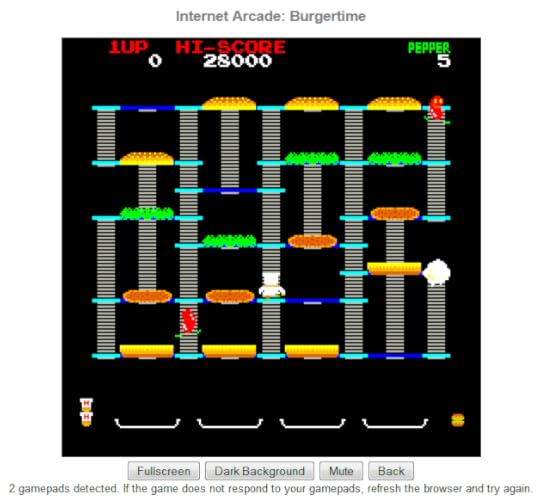
Burgertime play screen. While Burgertime, like other games on the Internet Arcade, has sound issues in the present version of the emulation, it’s still a blast to play.
So there you have it. Any questions, just ask, otherwise, have fun and be sure to support all of the Internet Archive‘s tireless and exhaustive efforts at preservation. There have already been several improvements to the Internet Arcade since launch, and I have no doubt that we’ll see even more over time.
Funding for Armchair Arcade
November 4, 2014
Lack of class from the AT&T Trade-in Program
Having recently upgraded my wife’s iPhone 5 to an iPhone 6 Plus on AT&T, we were able to take advantage of the AT&T Trade-in Program. Normally, we go through trade-in services like Gazelle or sell through eBay, but in this case the trade-in value was higher than Gazelle‘s and (presumably) less hassle than eBay. In any case, after waiting for several weeks for the trade-in to process – AT&T stated the reason was an excess volume of trade-ins – we finally received our card.
Unfortunately, it’s not like a credit or debit card, but is considered a type of promotional card that’s only good at an AT&T store, either physical or online. Nevertheless, it still needed to be activated to work via one of two options: online or phone call. For whatever reason, I chose phone call, and, to my surprise, as soon as the call connected I was greeted with a “you just won a $100 Wal-Mart gift card!” (I’m roughly paraphrasing this and other events).
OK, that’s odd, I thought, but I proceeded to be connected to an operator. This woman – who was almost certainly based outside of the US (not normally an issue, but the call quality was low and her accent a bit thick) – proceeded to go into her pitch about the Wal-Mart gift card. She wanted my address and to connect me with her “supervisor” who would take a small fee of $4.95 (if I recall correctly) to mail me the card. I asked if this is going to sign me up for a subscription service of some type. She more or less talked around/tried to avoid that idea/impression, but clearly that’s what it was.
In any case, not wanting to participate in nonsense and simply wanting to proceed to actually doing the thing I specifically called for – activate my promotional card – I told her that I’m not interested and would just like to activate my card. From there, I proceeded to get the “hard sell” with the rep wanting to know why I wasn’t interested in the program and her wanting to connect me to her supervisor to get the gift card. I again restated that I’m not interested and just wanted to activate the card. Silence. Click. She hung up on me.
Long story short, I went online (which I should have done in the first place) and activated the card. No hard sell, no nothing, just doing expressly what I wanted to get done in the first place. After that I called AT&T directly to find out if I could use the card to pay my bill. The answer was “yes,” but I had to do it online. Fair enough. I did it and it worked, but boy was I not happy about the process leading up to that simple resolution. In the future, because of this, I’ll absolutely be going to the Gazelle or eBay route (in fact I did the former for my own phone recently).
Why a company the size of AT&T has to deal with the type of promotion card company that they’re presently dealing with is beyond me. Are the few extra dollars in presumed commission worth harassing your customers? As you can tell from this post, it almost certainly isn’t.
November 2, 2014
Recent homebrews for MSX, ColecoVision, Intellivision, CreatiVision, Dragon, Turbo-Grafx/16, Vectrex
Here are some quick photos of recent multi-platform homebrews I’ve been checking out:
MSX platform: Uridium (an incredible port of the Commodore 64 technical tour de force), Jawbreaker II (a port of the TI-99/4a version of the maze game classic), and Monster Sound FM Paq Cartridge (an MSX MUSIC / FM PAC 100% compatible sound cartridge). My colleague, Mark Vergeer, provided a first look video at this MSX port of Uridium.
Coleco ColecoVision: Nibbli: Son of Nibbler (a port of the “closet classic” arcade game).
Mattel Intellivision: Space Raid (inspired by Sega’s arcade classic, Zaxxon).
CreatiVision: A new multi-cart, Multirom v1.0 for the CreatiVision. Note that I have several Dick Smith Wizzard variants of the original CreatiVision, including the one pictured, which has a composite output modification. It’s quite difficult getting this Australian-based computer working here in the US, including not only converting the power supply, but also getting a display on the right TV. At the moment, I only have it working on a Sharp world TV, the CRT-based model you see pictured. The mess is due to making sure everything worked, which was quite hit or miss regardless of the console I used.
Dragon: This “Dragon DriveWire” is a nicely cased Tano Dragon/Dragon 32/64 version of the popular Tandy/Radio Shack Color Computer DriveWire that lets you use your modern computer as a file server to the classic computer, among other features.
NEC Turbo-Grafx/16, Intellivision Flashback: To the right of the original 2.5″ LCD screen NEC TurboExpress is a modded TurboExpress. The modded unit has a modern 3.5″ LCD that all but eliminates motion blur and greatly increases battery life. Other mods include a controller port and A/V out to use an external display. The two controller adapters pictured allow you to use the new Intellivision Flashback controllers on systems like the Intellivision II.
GCE Vectrex: The overdrive controller that works on games like Hyperchase.
October 31, 2014
The wearables and fitness and sleep tracking dilemma
As a long-time technology and fitness enthusiast, I’m the perfect target for what is now becoming an avalanche of devices designed to help us be healthier, track our sleep patterns, and give us all kinds of purportedly useful data about our general state of being. Naturally, as a result, Microsoft’s recent announcement and release of their Microsoft Band and Nintendo’s reveal of additional details about their Quality of Life Sensor caught my eye.

My Pebble watch on my left wrist
Of course, I’m already well on the sensor bandwagon, presently sporting a Kickstarter Pebble watch and a Jawbone Up24 – just two of the latest in a series of such devices I’ve had – but I’m always looking to upgrade to something even better. Frankly, if I wasn’t switching off of Android and going back to iOS, I’d already likely be sporting a Motorola Moto 360 instead of my Pebble. As it stands now, since I have an iPhone 6 Plus on the way, my decision will more or less come down to the Microsoft Band or simply waiting for the as-of-yet-unfinished-and-unreleased Apple Watch.
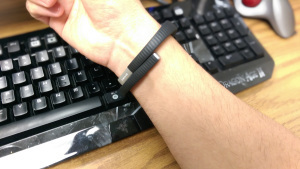
My Jawbone Up24 on my right wrist
One reason I won’t be replacing my Up24, which I wear on my right wrist, is that it’s presently the only such device that not only tracks sleep, but also wakes you at either a time you set or what it determines as the optimal time withing a preset window (more or less when you’re already restless, resulting in a gentler wake up cycle). It does the latter with a simple vibration, something Nintendo’s nighstand-killing Quality of Life Sensor doesn’t even offer. In fact, if it’s not on my person, I don’t even consider such devices much use since they need to “scan” you from afar.
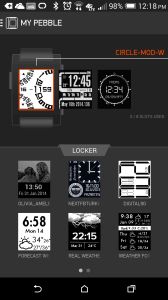
The functional, but limited Pebble app on my phone
As for my Pebble watch, it’s reasonably priced and does exactly what it claims it does. While I no longer get week-long battery life out of it (more like half a week), I’m able to wear it all of the time, including in the shower, since it’s waterproof. That’s a big plus in my book and not something that many other smartwatches or fitness bands offer, including the new Microsoft Band. Of course, the Pebble isn’t perfect, including requiring two apps – it’s own and a third party one called Pebble Notifier – to give me all of the notifications I desire. That’s not exactly efficient use of my phone’s resources.
There are other, more minor downsides to the Pebble, including limited two way interaction (it’s mostly a receiver), lack of sensors, and a relatively simple e-ink-like display, but it mostly comes down to nitpicks. You’re either happy with what the Pebbler offers (and hopefully know what it offers going in) or desire something more akin to the Moto 360.
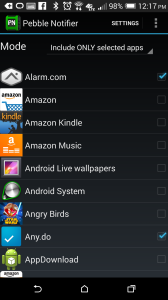
The excellent, but what should be unnecessary, third party Pebble Notifier app
One of the nice things about the Microsoft Band is that it’s more or less platform agnostic, working with Android, iOS, and Windows Phone. Unfortunately, it’s only with the latter that you get to speak through the band via Cortana integration. While this is not dissimilar to watches like the Moto 360 or Apple Watch that only offer voice integration with their respective platforms (and of course only work on those platforms period), it does take a bit of the impact off the otherwise compelling bullet point of supporting all of the major smartphone platforms.
Of course, with the Microsoft Band, I also lose the waterproof feature of the Pebble, but this is not as big of a deal as it otherwise might be, because like I said, most such devices don’t really offer such a feature, including the Up24 (previous models did claim to support this, but the reality – and as my half dozen or so returns can attest – was that it really wasn’t). I’d still have the Pebble’s notifications (more or less) and gain a whole bunch of other functions (mostly) related to fitness and health tracking as well if I switched to the Microsoft Band.

The Up app on my phone
The other factor of course is that Apple’s Watch is going to debut some time early next year with a starting price of $349. I just know I’d end up spending more than that to go a bit beyond the base model. Contrast this to the Microsoft Band at $199 – albeit with a lesser and somewhat different feature-set – and it seems like an easier decision to make. Worst case, as with the Pebble, I can sell it to make some of the money spent back and put it towards the new device.
As you can see, these are not easy decisions and it very much depends on what you want out of these devices. Why more such devices don’t offer the sleep features of the Up24 is beyond me since it seems like a no-brainer option for something you wear on your wrist, assuming of course you don’t have to charge at night, which would defeat the purpose of having the feature in the first place (and, let’s face it, battery life is poor on these devices with even modest functionality almost across the board). As such, there’s no easy replacement for that device. In regards to the smartwatch/band thing, it’s a matter of choosing the least imperfect device for your needs. Hopefully at some point these devices will be perfected in a similar manner to how the latest smartphones are (where we now see incremental, rather than revolutionary improvements between releases), though likely that will take another three years or so at the rate things are going.
In any case, I’d love to hear your thoughts on the subject and what your personal approach is to this ever growing category of devices. It’s clearly a literal fight over our wrists, hearts, and minds by some major corporations with no clear leader at this point. While it’s fun to be in the middle of a new technological revolution, it’s not going to be quite as much fun to potentially be privy to some of the collateral damage that is bound to happen in this explosive market segment. Choose wisely and good luck.
October 30, 2014
Armchair Arcade is now social media enhanced
Just a quick heads up that I upgraded the Armchair Arcade Website to allow for major social media logins, commenting, and content sharing. What this means is that you can use your favorite major social media presence (Facebook, Twitter, Google+, etc.) to more easily interact with the Armchair Arcade Website. I hope to have a few additional tweaks and fixes in place within the next week or so, but what you see now is more or less the final vision of the new Armchair Arcade.
You can of course also find and follow Armchair Arcade on various social networks as well, follow our RSS feed, or follow individual Armchair Arcade editors. All of the relevant links and information should be easy to find throughout the site.
If you uncover any issues or would like to see certain features added or changed, just let me know in the comments, contact form, or via email and I’ll see what I can do to accommodate. Thanks as always for the support.
October 29, 2014
The Real Commodore Vic-20 Prototype
Thanks to Marty Goldberg and his post on the Facebook group, Vintage Gaming (& Computing), we were given the heads-up on John Feagan’s photo and commentary on some early Commodore Vic-20 history. Here’s John’s commentary:
History of the Vic-20 development has been rewritten by the non-participants–but I have the pictures. Here is the real deal developed at the Commodore Advanced Moorepark development center in San Jose, CA in July 1980. It took another year of production engineering and a launch in Japan before it made it to the US. My wife translated the users manual to English from Japanese.
![The original Commodore Vic-20 Prototype. [Photo credit: John Feagan]](https://i.gr-assets.com/images/S/compressed.photo.goodreads.com/hostedimages/1414621824i/11672113.jpg)
The original Commodore Vic-20 prototype [Photo credit: John Feagan]
So there you have it, history from the source. You’ll note in the photo that the Vic-20 prototype is styled similarly to the original Commodore PET from 1977, complete with funky calculator-style keyboard. Naturally, upon its actual retail release, the Vic-20 would receive its own, larger case, the iconic “breadbox” design and a full stroke keyboard, both of which would also be found in the iconic and best selling Commodore 64 just a few years later (and similarly found on all PET computers after the original models).Interestingly, having a full stroke keyboard on a low end/budget computer like the Vic-20 was actually something of a coup for Commodore, as most such releases from other companies featured lower cost chiclet or membrane-style keyboard parts (and in fact, one Commodore Japanese-only release featured just such a compromise). As detailed in books like our own CoCo: The Colorful History of Tandy’s Underdog Computer, even penny savings were often the difference between one part being included in a production run of a computer over another, since even the smallest amount saved could translate to big money over tens or hundreds of thousands of units (if not eventually millions).


